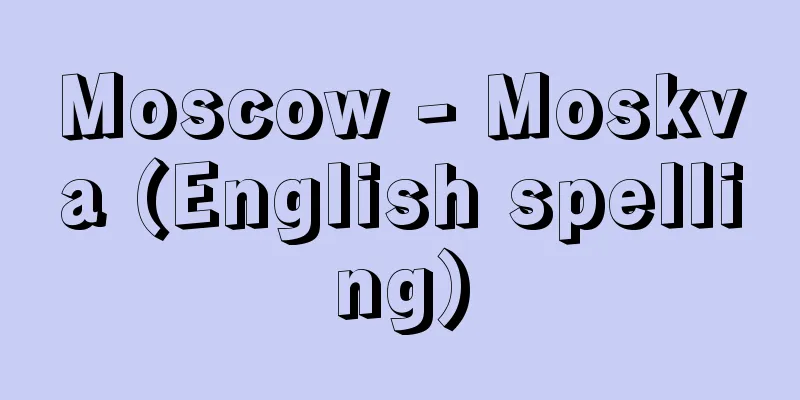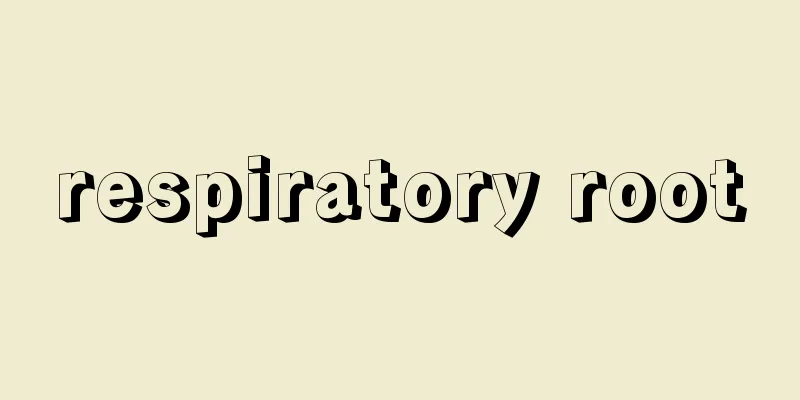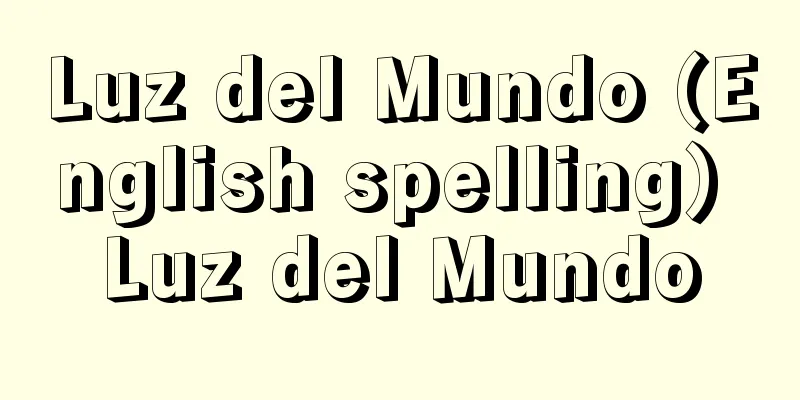Moscow - Moskva (English spelling)

|
The capital of the Russian Federation. The Moscow River, a tributary of the Oka River that runs through the center of European Russia in the center of the East European Plain, meanders through the city. The city's English name is Moscow. It developed due to its convenient transportation, the presence of raw materials for handicrafts in the vicinity, and its role as the center of northeastern Russian cities. The city has an area of 994 square kilometers and a population of 8,630,400 (estimated as of 2000). The average elevation is 120 meters, with the highest point being Vorob' yovï Gorï (Sparrow Hills), 253 meters above sea level, on the former Lenin Hill in the southwest. [Taizo Nakamura] climateIt has a relatively mild continental climate, with an average annual temperature of 5.3°C, with the coldest month being -7.5°C in January and the warmest month being 18.4°C in July. The climate fluctuates greatly from year to year, with sudden changes in temperature, making living conditions less favorable than in Paris. The average annual precipitation is 705 mm, with most rain in summer and autumn. The average snowfall is about 40 centimeters, but thanks to the use of snowplows in the winter, road traffic within the city is maintained at all times. [Taizo Nakamura] residentsThe population was 7.172 million in 1970, but has increased by 1.5 million in the 25 years since. The population density is about 8,700 people per square kilometer, which is higher than other large cities in Russia. The birth rate is 8.0 per 1,000 people, and the death rate is 16.9 (1995), which is a large natural decrease compared to previous years. The death rate has exceeded the birth rate since 1989. Therefore, the population decrease has been compensated for by influx of people, but this has not been enough to compensate for the natural decrease, and the population has been decreasing since about 9 million in 1989. Over 80% of the residents are Russian, with other ethnicities including Ukrainians, Jews, Tatars, and Belarusians living there. On the other hand, the divorce rate is high, with 8.2 marriages and 4.6 divorces per 1,000 citizens (1995). In addition, the population structure has a high ratio of elderly people (2.3 million pensioners in 1995) and a small child population. [Taizo Nakamura] industryThere are approximately 5.2 million employed people, but in the 30 years from 1965 to 1995, the proportion of industrial workers fell by 50%, and instead there was a large increase in those working in construction, commerce, education, culture, the arts, finance, and insurance. Those working in the industrial sector accounted for 18.0% of the total workforce, followed by commerce at 16.0%, construction at 13.5%, scientific research and its services at 10.8%, education, culture, and the arts at 9.6%, and transportation at 7.2% (1995), making it a multi-functional city. Industrial production in the country is said to account for approximately 5% of Russia's total production, making it a major center of Russian industrial production. The number of employees is decreasing year by year, but labor productivity is increasing. In terms of the number of employees, the main industrial sector is the machinery and metal processing industry, which accounts for 50.2% of industrial workers. This sector has the highest growth rate of all industrial sectors. Next is light industry at 14.0%, building materials at 13.7%, food at 7.5%, chemicals at 3.7%, and building materials at 13.7% (1992), but aside from the machinery industry, the printing industry has the highest growth rate, and light industry and food industry production are declining. The scientific research and service sector, which handles research, design and its management, and services, employs approximately 600,000 people, meaning that more than a quarter of Russia's workforce in this field is concentrated in the capital. Moscow is home to nearly 1,000 scientific, design and information-related institutions, including the Academies of Sciences in various fields, such as the Barzin Central Research Institute of Ferrometallurgy, Hydroproekt (for the development of hydroelectric power plants), Hydromedz (for the design and engineering of metallurgical plants), and Vinitey (All-Russia Scientific and Technical Information). More and more people are working in commerce and finance. This sector was underdeveloped in the past, but the shift to a market economy has led to a significant increase in small privately run commercial enterprises. Moscow's per capita merchandise sales are among the highest of any large Russian city, more than twice the Russian average and 50% higher than St. Petersburg. Since the 1991 economic reforms, the import of foreign products has increased, putting pressure on domestic sales. The number of supermarket-style stores and convenience stores has increased. The number of restaurants has also increased, reaching 8,190 (1993), including cafes and buffets. Most of these are facilities attached to companies and schools, but the number of independently run establishments has increased recently. The number of banks has increased rapidly since the establishment of private commercial banks in addition to state-run banks was permitted, and about 40% of Russian banks are concentrated in Moscow (1996), with many of them being large banks. [Taizo Nakamura] trafficMoscow is a major transportation center of Russia, and is connected to other parts of Russia and other countries by four airports, ten railways, federal highways 1 to 11, and three river ports. Four airports, including Sheremetyevo International Airport on the outskirts of Moscow, have frequent passenger aircraft arrivals and departures, and not only do they function as an important gateway to Russia and connect with other countries, but they also play a major role in connecting various parts of the vast country. Railways also play an important role in long-distance transportation, but in recent years they have become more important for connecting cities and settlements near Moscow rather than long-distance transportation, and more people use them for commuting and recreation. The importance of trams in passenger transportation within the city has decreased, but the subway has developed instead, with 11 lines and a total length of 255 kilometers (1995). In passenger transportation, the subway carries 45% of all passengers (1995), surpassing buses. Buses still play a large role in transporting passengers within the city, and since the 1960s, suburban and long-distance bus transportation has also developed. The city's three river ports serve as the base for transporting important goods in and out of Moscow, as well as passenger transport. There are long shipping routes from here to Astrakhan at the mouth of the Volga River, as well as shorter routes to points near Moscow, and hydrofoils operate for sightseeing within the city as well as to nearby destinations. [Taizo Nakamura] Education, Culture and TourismMoscow is also a city of students. There are 80 higher education institutions, including Moscow State University, and the number of students has decreased from before to 450,000 in 1995, but since the end of the 1980s, private and public universities have begun to be established. There are 61 theaters, 106 art galleries and museums, and 450 libraries. There are many world-famous facilities, such as the Grand Kremlin Palace, which can accommodate nearly 6,000 people, the Bolshoi Theater, the Maly Theater, the Kremlin Museum (Armory), the Tretyakov Gallery, the Pushkin Museum, and the Russian State Library (formerly the Lenin Library), which is the largest in the world. In addition, Kolomenskoye, which is home to a collection of Russian-style historical buildings, has been preserved and is used for museums, and within the 15th-century walled Kremlin, there are many 15th- and 16th-century churches, such as the Dormition Cathedral and the Blagoveshchensky Cathedral. Red Square, adjacent to the northeast of the Kremlin, is home to Basil's Cathedral, a representative 16th-century Russian building, and is visited by many domestic and foreign tourists. The annual number of theatergoers was 8.3 million, and the number of visitors to art galleries and museums was 37.74 million (1992). [Taizo Nakamura] Green Spaces and HousingAbout two-thirds of the city's area is built up, and about 20% is green space. Since the late 1950s, a large amount of housing construction has led to the formation of large housing complexes in the fringes close to the city border, bringing about major changes to the city's landscape. Houses built before World War II now account for just over 9% of the total residential area, while new housing built in the 1970s accounts for one-third. At the same time, the number of high-rise buildings has increased, with apartments over 10 stories accounting for nearly 60% of the total residential area, and 20% over 16 stories (1995). As a result, nearly 100% of the city has water, sewerage, and central heating facilities, and just over 60% has gas facilities. [Taizo Nakamura] Moscow metropolitan area and urban planningMoscow is generally divided into three zones. The inner city is the city center, where administrative, commercial and cultural facilities are concentrated. The outer area of the city, which existed until 1960, is the intermediate zone, which is 7.4 km from the Kremlin on average, and is a mixture of industrial and residential areas and transport centers (railway terminals). It is undergoing redevelopment and has seen a significant decline in the permanent population. The third zone is the new Moscow area, which is 14 km from the Kremlin on average and accounts for more than half of the city's total area. This zone is where new Moscow housing estates are being developed, and there is a lot of green space. This is the main city area, and the 109 km long expressway ring road borders the city, but since 1986 the city has expanded to some areas outside the ring road. Outside this area is the forest park zone (10-15 km wide, 1,800 km2 in area), where cities, settlements, and villas are scattered, and where more than 1.5 million people live. Outside this lies the suburban area, 50-70 km from the Moscow city border, which includes about 80 cities and towns with a population of over 2.5 million, and is part of the Moscow commuter belt. This area is also known as the Moscow Megalopolis. Moscow's urban planning focuses on solving various problems such as consolidating land use, clearly dividing functions, developing transportation networks, and protecting the environment. The plan is also being implemented with consideration given to the development of not only Moscow but also the Moscow metropolitan area. However, the plan has not necessarily gone according to plan, as can be seen from the fact that population concentration in Moscow and its surrounding areas has progressed faster than planned, despite the fact that population restrictions were implemented early on to prevent Moscow's expansion. In addition, there are calls for the immediate implementation of a variety of issues, including the conversion of industries in the industrial sector (development of advanced technology sectors, relocation of polluting factories, and conversion of military factories to production of civilian products), the prevention of urbanization in forested areas, improvement of environmental deterioration in city areas with severe air pollution, and the securing and improvement of recreational and rest facilities in the suburbs. [Taizo Nakamura] historyIt is known that a sizable settlement existed there already at the end of the 11th century, but the city's name first appears in chronicle records in 1147. At that time it was the domain of Suzdal prince Yuri Dolgorukiy, who is today considered the city's founder. Moscow's real development began when Daniil, the youngest son of Prince Alexander Nevsky, made it the capital of the Moscow Principality around 1276. The principality developed rapidly due to its geographical advantage and the ingenious domestic and foreign policies of successive princes, and the development of the city of Moscow was inseparably linked to it. Already in the first half of the 14th century under Ivan I, Moscow replaced Vladimir as the political and religious center of northeastern Russia. In the second half of the 14th century, an anti-Tatar struggle broke out among Russians against the rule of the Golden Horde (Tatars) that had continued since 1238, and Moscow played a central role in that struggle, and in 1380 Grand Prince Dmitry Donskoy of Moscow defeated a large Tatar army for the first time in the Battle of Kulikovo. During the reign of Ivan III in the second half of the 15th century, Russia gained independence from the Golden Horde, and the city began to develop rapidly. It was during his reign and that of his son Vasily III that the Kremlin took on the form we see today. During this period, the center of commerce and industry was the area to the east of the Kremlin, known as Great Posad. In the 16th century, this area came to be called Kitai-Gorod, and the "market" within it (which came to be called "Red Square" from the mid-17th century) was lined with numerous shops and was bustling with activity. In the 16th century, Moscow was heavily fortified against the invasion of foreign enemies (especially the Crimean Tatars). Not only the Kremlin, but also Kitai-Gorod and the outer Bely-Gorod were surrounded by stone walls from 1535-38 and 1586-93, respectively (these were demolished in the late 18th and early 19th centuries, and became the present-day Briar Ring). A third outer wall, Zemlyanoi Bar ("Earthen Wall"), was built in 1591-92. This was also the border of Moscow at the time, but was demolished in the first half of the 19th century, and today it is the Sadovoye Ring. Fortified monasteries (Andronikov, Novodevichy, Donskoy, etc.) were located around the city. Basil's Cathedral, which stands out today at the southern end of Red Square, was also built around this time, during the reign of Ivan IV (the Terrible). The city was occupied and suffered heavy damage by Polish troops in 1610-12 during the turbulent period after the fall of the Rurik dynasty, but was rebuilt shortly after the establishment of the Romanov dynasty, and its area expanded beyond Zemlyanoi Bar, with its population reaching 200,000 by the mid-17th century. In 1712, during the reign of Peter the Great, the capital was moved to the newly built St. Petersburg. However, Moscow remained the second capital and the economic and cultural center of Russia. The foundations of public education were laid as early as the beginning of the 18th century, and in 1755 the first Russian university, Moscow State University, was founded. The first public theater was also opened here, and a printed newspaper was published here. After the capital was moved, many of the government and central institutions continued to operate here for a total of 20 years until the end of the 18th century. The city's boundaries also expanded, and the Kamel-Khorezhsky Bar earthworks (over 37 km long) were built in 1742. Moscow's importance did not decline in the 19th century. This can be seen from the fact that in 1812, Napoleon's army invaded Russia and headed straight for Moscow, occupying it. A devastating fire raged through Moscow, lasting a week and destroying three-quarters of the city. The invading army retreated after 39 days, but not before blowing up part of the Kremlin. The Moscow City Construction Committee was established immediately after the war, and Moscow was rapidly rebuilt. It was at this time that the Neglinnaya River, which runs along the west side of the Kremlin, was culverted and the Alexandrovsky Garden was built on it. The Bely Gorod fortress walls and Zemlyanoi Bar were also demolished. The Bolshoi Theatre (which had already begun operations in the previous century), the Maly Theatre, and the Manezh (Horseback Riding Stadium) were also built. Living conditions in the city also improved, especially with the development of public transport. In the 1840s, the first public transport, a horse-drawn carriage, was installed, in the 1870s a horse-drawn railway, and in 1899 a streetcar. The population exceeded the level before the Napoleonic Wars in 1827 (275,000), and by 1862 it had reached 317,000. After the emancipation of the serfs (1861), the population grew even more rapidly, exceeding one million by 1897. The rapid population growth reflected Moscow's economic and cultural development during the period of capitalism, but it also brought about problems. At the beginning of the 20th century, more than 90% of the houses were wooden and one or two stories high, and only those living in the center benefited from urban development, with more than 70% of the population living in small dwellings without the basic amenities of life. Moscow was the main stage of the Russian Revolution in 1917, following its start in 1905. After the October Revolution of the same year, on March 11, 1918, the Soviet government moved from Petrograd (St. Petersburg) to Moscow, and Moscow became the capital again. Having overcome the crisis of civil war and intervention, the Union of Soviet Socialist Republics set out to build socialism with Moscow as its base. In 1940, Moscow's total industrial production was 21 times that of before World War I (1913) (metalworking was 96 times). In 1935, construction of the subway began. The population also grew, reaching 4.54 million in 1939. The Second World War (Great Patriotic War) caused great damage to the Soviet state. The German invaders were repelled several tens of kilometers west of Moscow, but the human and material damage caused by the war was enormous. This made the postwar reconstruction and development remarkable. Already by 1950, Moscow's industrial production had doubled compared to the pre-war level (1940), and by 1964 it had increased 4.9 times, making it literally one of the world's leading cities, a status that remains to this day. [Takeo Kuryuzawa] "Moscow Stories" by Lev Kolodny, translated by Miyazawa Shunichi (1979, Nauka)" ▽ "Moscow at the End of the Imperial Rule" by B.A. Gilyarovsky, translated by Murate Yoshiharu (1985, Chuokoron-Shinsha)" ▽ "Tales of the World's Cities Vol. 11/Moscow" by Kimura Hiroshi (1992, Bungeishunju) ▽ "Stalin and the City of Moscow 1931-34" by Shimotome Nobuo (1994, Iwanami Shoten)" [References] | | |The capital of the Russian Federation, located on the Moscow River, a tributary of the Oka River. It has developed as the central city of northeastern Russia since ancient times. The photo shows the view from near Sparrow Hills. Russia Moscow ©Shogakukan "> Moscow city Facing the northeast wall of the Kremlin, large-scale parades were held here during the Soviet era. Lenin's Mausoleum is in the center of the photo. Inside the wall, the Presidential Palace (right) and the Presidential Residence can be seen. Part of the World Heritage Site "Moscow Kremlin and Red Square" (Russia, registered in 1990) Russia Moscow ©Shogakukan "> Red Square and Lenin's Mausoleum Russia's oldest university. Since its founding in 1755, it has produced many world-famous scientists and writers. The 32-story high-rise building completed on Lenin Hill (now Sparrow Hills) in 1953 has become the symbol of the university. Russia Moscow ©Shogakukan "> Moscow State University Russia's leading opera and ballet theater. Founded in 1776, it is known as the home of the Bolshoi Ballet. The current building was rebuilt in 1856. It was once the political center of the country, hosting the Congress of Soviets. Russia Moscow ©Shogakukan "> Bolshoi Theatre Built in 1555-61 by Ivan IV (the Terrible). Currently, it is a branch of the Historical Museum at the northern end of Red Square, and houses frescoes from the time of its construction. Part of the World Heritage Site "Moscow Kremlin and Red Square" (Russia, registered in 1990) Russia Moscow ©Shogakukan "> Basil's Cathedral Source: Shogakukan Encyclopedia Nipponica About Encyclopedia Nipponica Information | Legend |
|
ロシア連邦の首都。東ヨーロッパ平原の中部、ヨーロッパ・ロシア中央部を貫流するオカ川支流のモスクワ川が、蛇行しながら市内を流れる。英語名モスコーMoscow。交通の便と付近に手工業の原料産地が存在したこと、また北東ロシア諸都市の中心であったことなどの理由により発展した。市域面積994平方キロメートル、人口863万0400(2000推計)。平均標高120メートル、最高点は南西部の旧レーニン丘のボロビヨーブイ・ゴールイВоробьёвы Горы/Vorob' yovï Gorï(雀(すずめ)が丘)253メートルである。 [中村泰三] 気候比較的温和な大陸性気候を示し、年平均気温5.3℃、最寒月1月零下7.5℃、最暖月7月18.4℃である。気候の年変動は大きく、寒暖の移行も急激であるので、パリに比べれば居住条件はよくない。年降水量705ミリメートルで、夏と秋に雨が多い。積雪量は40センチメートルほどであるが、冬季除雪車が活躍するので、市内の道路交通は常時維持されている。 [中村泰三] 住民1970年の人口は717万2000であったが、その後25年ほどで150万人増加した。人口密度は1平方キロメートル当り約8700人で、ロシアの他の大都市に比べて高い。出生率は1000人当り8.0人、死亡率は16.9人(1995)で、以前に比べて自然減が大きい。1989年より死亡率が出生率を上回っている。したがって、流入人口により人口減を補ってきたが自然減を補えず、人口は1989年の約900万人以降、減少している。住民の80%強はロシア人で、ほかにウクライナ人、ユダヤ人、タタール人、ベラルーシ人など多民族が居住している。他方、市民1000人当りの婚姻は8.2人、離婚は4.6人(1995)で、離婚率が高い。また、人口構成は老齢人口比率が高く(年金生活者は1995年、230万人)、幼年人口が少ない。 [中村泰三] 産業就業者は約520万人であるが、1965~95年の30年間に、工業従事者の比重が50%減少し、かわって建設、商業、教育・文化・芸術、金融、保険業従事者などが大きく増えた。工業部門の従事者は、全就業者の18.0%で、次に商業16.0%、建設13.5%、科学研究とそのサービス部門10.8%、教育・文化・芸術9.6%、交通7.2%と続き(1995)、多機能都市になっている。 工業生産はロシアの約5%を占めるといわれ、ロシアの工業生産の大中心地である。従業者は年々減少しているが、労働生産性は上昇している。従業者数からみて、主要工業部門は機械・金属加工業で、工業従事者の50.2%を占める。この部門は全工業部門のなかで成長率が非常に高い。次に軽工業14.0%、建築資材13.7%、食品7.5%、化学3.7%、建築資材13.7%と続くが(1992)、成長率が高いのは、機械工業を除けば印刷工業で、軽工業、食品工業生産は低下している。 研究、デザインとその管理、サービスなどを扱う科学研究・サービス部門は、従業者が約60万人を占め、ロシアのこの分野の従事人口の4分の1以上が首都に集中していることになる。モスクワには各分野の科学アカデミーをはじめ1000近くの科学、デザインやそのインフォメーションに関する機関があり、バルジン記念鉄冶金(やきん)中央研究所、ギドロプロエクト(水力発電所の開発)、ギドロメズ(冶金工場の設計・デザイン)、ビニテイ(全ロシア科学・技術インフォメーション)などの諸機関が立地している。 商業と金融に従事する人々も多くなっている。かつてこの分野は未発達であったが、市場経済への転換により、私営の小規模商業企業が著しく増加した。モスクワの人口1人当り商品販売高はロシアの大都市のなかで非常に高く、ロシア平均の2倍以上、サンクト・ペテルブルグより50%高い。1991年の体制変革後は外国製品の輸入が増大し、国産品の販売を圧迫している。スーパーマーケット方式の店舗やコンビニエンス・ストア形式の店が増えた。飲食店の数も以前に比べて増加しており、カフェー、ビュッフェを入れて8190(1993)を数える。その多くは企業、学校に付属する施設であるが、最近は独立経営の店が増えている。銀行は国営銀行以外に民間商業銀行の設立が認められて以来急増、モスクワにロシアの銀行の約40%が集中し(1996)大規模銀行が多い。 [中村泰三] 交通モスクワはロシアの大交通中心地で、四つの空港、10本の鉄道、1号から11号までの連邦道、三つの河港によりロシア各地や外国と結ばれている。モスクワ郊外にあるシェレメティエボ国際空港など四つの空港の旅客機の発着は頻繁で、ロシアの玄関として外国との連絡に重要な機能をもつのみならず、広大なロシア各地を結ぶうえで大きな役割を果たしている。鉄道も遠距離輸送に重要な役割をもっているが、近年は長距離よりもモスクワ近郊の都市や集落と連絡する役割が増え、通勤、レクリエーションなどに利用する人々が多くなっている。市内では乗客輸送に占める市電の重要度は低くなったが、かわって地下鉄が発達し、11路線総延長255キロメートル(1995)に達する。乗客輸送ではバスを抜いて全乗客の45%(1995)を地下鉄が運んでいる。バスは市内の乗客を運ぶうえでなお大きな比重を占めているほか、1960年代以降、近郊バスや遠距離バスの交通も発達している。市内に三つある河港はモスクワ内外の重要な物資の運搬にも、また旅客輸送の発着点としても利用されている。ここからボルガ川河口のアストラハンまで走る長大な航路も、モスクワ近郊の地点との間を結ぶ短距離の航路もあり、水中翼船が市内観光だけでなく近郊への航路にも就航している。 [中村泰三] 教育・文化・観光モスクワは学生の町でもある。モスクワ大学をはじめとして高等教育機関は80あり、学生数は1995年度45万人と以前より減少しているが、80年代の終わりごろから、私立大学や公立大学が設立され始めた。劇場数は61、美術館・博物館は106、図書館450を数える。6000人近い収容数をもつクレムリン大宮殿、ボリショイ劇場、マールイ劇場やクレムリン美術館(武器庫)、トレチャコフ美術館、プーシキン美術館や世界最大の規模を誇るロシア国立図書館(旧レーニン図書館)など、世界に知られた施設が多い。このほか、ロシア様式の歴史的建造物が集まるコロメンスコエなどが保存されて博物館などに利用され、壁に囲まれた15世紀の城塞(じょうさい)クレムリンの中にはウスペンスキー寺院、ブラゴベシチェンスキー寺院など、15、16世紀の寺院も多い。クレムリンの北東に隣接する「赤の広場」には、16世紀ロシアの代表的建築物であるワシリー大聖堂などがあり、内外の観光客が多数訪れる。年間の劇場観客数は830万人、美術館・博物館訪問者は3774万人を数える(1992)。 [中村泰三] 緑地・住宅市域の約3分の2の面積に建物が建ち、約20%が緑地である。1950年代後半以降の大量の住宅建設により、市境に近い縁辺部に大規模な団地が次々と形成され、景観に大きな変化をもたらした。第二次世界大戦前に建てられた住宅は全住宅面積の9%強にすぎなくなり、1970年代に建設された新しい住宅が3分の1を占めるようになった。それとともに高層住宅が増え、10階建て以上のアパートが全住宅面積の60%に近く、16階建て以上が20%(1995)になっている。その結果、水道、下水道、集中暖房設備が100%近く普及し、ガス設備が60%強となっている。 [中村泰三] モスクワ都市圏と都市計画モスクワ市内は通常3地帯に分けられる。サドーボエ環状道路内が都心で、ここに行政、商業、文化施設が集中している。その外側の1960年までの市域が中間地帯で、クレムリンまで平均7.4キロメートルあり、工業・住宅地区と交通中心地(鉄道ターミナル)が混在しており、再開発が進み、常住人口の減少が著しい。第三の地帯はモスクワの新市域で、クレムリンまで平均14キロメートルあり、市の総面積のなかば以上を占めている。この地帯がモスクワの新しい住宅団地の造成地で、緑地も多い。ここまでが主要市域で、全長109キロメートルの高速環状自動車道が市域を境していたが、1986年より環状線外の若干の地区にも市域が広がった。ここから外に森林公園地帯(幅10~15キロメートル、面積1800平方キロメートル)があり、都市、集落が点在し、別荘もあり、150万人以上の人々が住んでいる。この外側に近郊地帯があり、モスクワ市境から50~70キロメートルの範囲内にある。この地域は約80の都市、町を含み、250万を超える人口を抱え、モスクワ市内への通勤地帯に入り、この地帯までをモスクワ・メガロポリス(モスクワ大都市圏)とよんでいる。 モスクワの都市計画では土地利用の集約化、明確な機能区分、交通網の整備、環境の保全など種々の問題の解決に力が注がれている。また、モスクワだけでなく、モスクワ都市圏の整備も考慮して計画が進められている。しかし計画どおりにかならずしも進んでいないのは、モスクワの膨張を防ぐため早くから人口制限が行われてきたにもかかわらず、モスクワとその周辺への人口集中が計画を上回る速さで進んだことからもわかる。 またそのほかに、工業部門での業種転換(先端技術部門の育成、公害を引きおこす工場の移転、軍需工場の民需製品生産工場への転換)、森林地帯で進む都市化の防止、大気汚染の著しい市域における環境悪化の改善、郊外でのレクリエーション、休養施設の確保と充実など、さまざまな問題の早急な実施が求められている。 [中村泰三] 歴史11世紀末にすでに相当規模の集落が存在していたことが知られているが、市名が年代記の記録上に最初に現れるのは1147年のことである。当時それはスズダリ公ユーリー・ドルゴルーキーの領地であったので、今日では彼が市の創始者とみなされている。 モスクワの本格的な発展は、アレクサンドル・ネフスキー公の末子ダニールが1276年ごろここをモスクワ公国の首都とするに及んでのことである。公国は地理的利点と歴代諸公の巧妙な内外政策により急速に発展するが、モスクワ市の発展もそれと不可分に結び付いていた。すでに14世紀前半のイワン1世治世には、モスクワはウラジーミルにかわって北東ロシアの政治・宗教上の中心となった。14世紀後半、1238年より続いたキプチャク・ハン国(タタール)支配に対し、ロシア人の反タタール闘争が起こったが、モスクワはその中心的役割を果たすようになり、1380年にはモスクワ大公ドミトリー・ドンスコイがクリコボの戦いで初めてタタールの大軍を撃ち破った。 15世紀後半のイワン3世治世下に、ロシアがキプチャク・ハン国から独立するとともに市の急速な発展が始まる。クレムリンが今日みられるような形になったのも、基本的には彼とその子ワシリー3世の治世下のことである。この時期、商工業の中心はクレムリンの東方に広がる地域で、大ポサードとよばれた。それは16世紀にはキタイ・ゴロドとよばれるようになるが、そのなかの「市場」(17世紀中葉から「赤の広場」とよばれるようになる)には多数の店舗が並び、活発なにぎわいをみせた。 16世紀のモスクワは、外敵(とくにクリミア・タタール)の侵入に備えて堅固な防備を施された。クレムリンはいうまでもなく、キタイ・ゴロドも1535~38年、さらにその外側のベールイ・ゴロドも1586~93年に石の城壁で囲まれた(これは18世紀末から19世紀初めに撤去され、今日のブリワール環状道路となる)。さらに第三の外壁ゼムリャノイ・バール(「土塁」)が1591~92年につくられた。これは当時のモスクワの境界線でもあったが、19世紀前半に撤去され、今日サドーボエ環状道路となっている。町の周辺には要塞(ようさい)化された修道院(アンドロニコフ、ノボジェービチー、ドンスコイなど)が配置されていた。今日赤の広場の南端に独特な姿を見せているワシリー大聖堂もこのころイワン4世(雷帝)治世下に建立された。市はリューリク朝断絶後の動乱時代の1610~12年に、ポーランド軍によって占領され大きな被害を受けたが、ロマノフ朝成立後まもなく復興され、市域もゼムリャノイ・バールを越えて発展し、17世紀なかばには人口も20万に達した。 ピョートル大帝治世の1712年、首都は新たに建設されたサンクト・ペテルブルグに移された。だがモスクワは第二の首都として依然として経済・文化の中心であり続けた。すでに18世紀初頭には一般市民のための学校教育の基礎が置かれ、1755年にはロシア最初の大学、モスクワ大学が創設された。最初の公共劇場が開設され、印刷新聞が発行されたのもこの地においてである。遷都後も18世紀末までの通算20年間にわたり、政府と中央機関の多くがこの地で活動した。市域も拡大し、市の境界は1742年に築かれた土塁カメル‐コレシスキー・バール(全長37キロメートル余)となった。 19世紀に入ってもモスクワの重要性は衰えなかった。そのことは1812年にロシアに侵入したナポレオン軍が一路モスクワを目ざし、占領したことからもうかがえる。このときモスクワを襲った大火は1週間続き、全市の4分の3が失われた。侵入軍は39日後に撤退したが、それに先だってクレムリンの一部を爆破した。戦後ただちにモスクワ市建設委員会が発足し、モスクワは急速に復興した。クレムリンの西側を走るネグリンナヤ川が暗渠(あんきょ)となり、その上にアレクサンドロフスキー庭園ができたのはこのときのことである。ベールイ・ゴロドの城壁とゼムリャノイ・バールも撤去された。またボリショイ劇場(すでに前世紀に活動を始めていた)やマールイ劇場、調馬場(マネージ)なども建造された。 市の居住条件も改善された。とくに公共交通の発達が顕著であった。1840年代には最初の公共交通機関である大型四輪馬車が、70年代には馬車鉄道が、99年には市街電車が走り始めた。人口も1827年には対ナポレオン戦争前の水準を超え(27万5000)、62年には31万7000となった。農奴解放(1861)後の人口増はさらに急で、97年には100万を超えた。人口の急増は資本主義発達期のモスクワの経済的・文化的発展の反映であったが、他方ひずみも出てきた。20世紀初頭において90%以上の家屋は木造の1ないし2階建てであったし、都市整備の恩恵を受けたのは中心部に住む人々だけであり、70%以上の住民は生活上の基本的な設備もない狭い住居にひしめいていた。 モスクワは、ロシア革命が開始された1905年に続き、17年にもロシア革命の主要な舞台となった。同年の十月革命後、1918年3月11日、ソビエト政権はペトログラード(サンクト・ペテルブルグ)からモスクワへ移り、モスクワはふたたび首都となった。内戦と干渉戦の危機を乗り越えたソビエト社会主義共和国連邦は、モスクワを拠点に社会主義建設に乗り出した。1940年には、モスクワの全工業生産は第一次世界大戦前(1913)のそれの21倍に達した(金属加工業は実に96倍であった)。1935年には地下鉄の建設が始められた。人口も増え、39年には454万に達した。第二次世界大戦(大祖国戦争)はソビエト国家に大きな被害をもたらした。ドイツ侵入軍はモスクワの西方数十キロメートル地点で撃退されたが、戦争による人的・物的損害は甚大であった。それだけに戦後の復興と発展は目覚ましかった。すでに1950年には、モスクワの工業生産高は戦前(1940)の2倍に達し、64年には4.9倍となり、文字どおり世界有数の大都市となって、今日に至っている。 [栗生沢猛夫] 『レフ・コロドヌイ著、宮沢俊一訳『モスクワ物語』(1979・ナウカ)』▽『B・A・ギリャロフスキー著、村手義治訳『帝政末期のモスクワ』(1985・中央公論社)』▽『木村浩著『世界の都市の物語〈11〉/モスクワ』(1992・文芸春秋)』▽『下斗米伸夫著『スターリンと都市モスクワ1931―34年』(1994・岩波書店)』 [参照項目] | | |オカ川支流のモスクワ川畔に位置するロシア連邦の首都。古くから北東ロシアの中心都市して発展してきた。写真は雀が丘付近からの眺望。ロシア モスクワ©Shogakukan"> モスクワ市街 クレムリンの北東側城壁に面し、ソ連時代には大規模なパレードが行われた。写真中央はレーニン廟。城壁の内側には大統領府(右)と大統領官邸がみえる。世界文化遺産「モスクワのクレムリンと赤の広場」の一部(ロシア・1990年登録) ロシア モスクワ©Shogakukan"> 赤の広場とレーニン廟 ロシア最古の大学。1755年の創設以来、世界的な科学者、文学者などを多数輩出している。1953年レーニン丘(現在の雀が丘)に完成した32階建ての高層建築は大学のシンボルとなっている。ロシア モスクワ©Shogakukan"> モスクワ大学 ロシアを代表するオペラとバレエの常設劇場。1776年の創設で、ボリショイ・バレエ団の本拠として知られる。現在の建物は1856年に再建された。かつてはソビエト大会が開かれるなど、政治の中心でもあった。ロシア モスクワ©Shogakukan"> ボリショイ劇場 イワン4世(雷帝)により1555~61年に建築。現在は赤の広場北端にある歴史博物館の分館となっており、創建当時のフレスコ画などを収蔵する。世界文化遺産「モスクワのクレムリンと赤の広場」の一部(ロシア・1990年登録) ロシア モスクワ©Shogakukan"> ワシリー大聖堂 出典 小学館 日本大百科全書(ニッポニカ)日本大百科全書(ニッポニカ)について 情報 | 凡例 |
<<: Moscow Canal (English spelling)
>>: Moskvin, Ivan Mikhailovich
Recommend
Nobuna Kada
…In April 1802, Mabuchi gave a lecture on the Hya...
Kāsī (Kāsi) (English spelling) Kasi
...An ancient Indian kingdom in the eastern part ...
Karasuzansho - Karasuzansho
A deciduous tall tree of the Rutaceae family (APG...
Nude mouse - Nude mouse (English spelling)
A mouse mutant that is congenitally hairless and ...
Speaking in tongues - Igengensho
…Ian Stevenson of the University of Virginia in t...
Kyomasu - Kyomasu
The shakkanho masu (measures based on the shakkan...
Akita silver
〘Noun〙 A general term for various silver coins min...
Alexandre‐Jean‐Baptiste Parent‐Duchatelet
1790‐1836 A French medical scientist, he conducted...
Labor productivity
A ratio that indicates how much production is prod...
Carolus-Duran, EA
…In the early Hakuba-kai exhibitions, he exhibite...
Proofreading back cover text - Proofreading back cover text
…In the narrow sense of the word, draft texts may...
Kana writing - Kanagaki
... As the number of people using kanji increased...
Closure - Finish
A type of informal Noh performance. It is perform...
Season cracking
Hydrogen embrittlement is a process that occurs w...
Kornmannia zostericola (English spelling)
...They are also cultivated. In cold waters such ...








![Odate [city] - Odate](/upload/images/67cb16356ffc7.webp)
